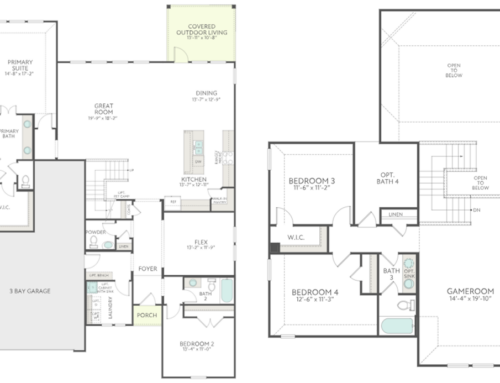Patio homes can be a great choice for homeowners who don’t need a large yard. In this article, we’ll discuss the unique qualities of these homes and why more buyers are choosing to move to patio home communities.
Patio Home Definition
Patio homes—also called garden homes or carriage homes—are just like any other home on the inside, in terms of living spaces, bedrooms, bathrooms, etc. But these homes are designed to make the most of the lot they are built on.
Patio homes are usually built on smaller plots and are designed to maximize the lot’s square footage. The result is that patio homes typically have smaller yards, making them ideal for homebuyers who prefer to do minimal yard work. This type of home may or may not have an actual patio, but most do have a small landscaped area in the back that might include a courtyard, patio, or other type of outdoor living area.
Patio Home vs. Townhouse vs. Condominium
So how is a patio home different from a townhouse or a condominium? In some regions of the country, the term patio home is used for a type of dwelling that is very similar to a townhouse or condo. Both a patio home and a townhome include lot ownership. A townhouse will typically share a wall with a neighboring unit and will often have two or even three stories.
Condominiums, like townhomes, also share a wall with one or more neighboring units. But unlike townhome owners, a condo owner does not own the exterior of the unit/building, or the lot the unit sits on. This means the condo owner is not responsible for maintenance of the exterior of the unit, any common areas, or the building’s grounds. Typically, condo owners will be members of a condominium owners’ association and dues to this organization will pay for maintenance of the grounds and exterior.
Here in North Texas, patio homes, like those at Union Park by Hillwood in Little Elm, are freestanding homes that do not share a wall with another unit. The owner of a patio home at Union Park also owns the land the home sits on.
Pros and Cons of Patio Homes
Patio homes are single-family homes that offer almost all the benefits of a traditional home in a smaller package. If you’re considering a patio home but can’t decide, consider the following factors:
Privacy
Patio homes are much more private than townhomes or condos. With shared walls, you’re much more likely to hear what’s going on inside your neighbor’s unit or smell their dinner cooking. This isn’t a concern with a freestanding patio home like those at Union Park.
Affordability
Garden homes are attractive to many homebuyers because they typically offer more home for the money. A patio home is built on a smaller lot, with the home’s footprint taking up most of the property. If a large yard is not a necessity, the homebuyer can get a home with all the features they are looking for at a lower price because of the savings on the land.
Low Maintenance
One of the main advantages of garden homes over traditional homes is that they require less yard maintenance. Most patio homes have a front yard and a small green space in the back that may have a patio or outdoor living area. If they choose to install a no-mow backyard, owners of patio homes at Union Park may not even need to own lawn mowing equipment. This is because front yard mowing, edging, weeding, and fertilizing services are provided by the Union Park HOA.
Homeowners’ Association
Like most townhomes and condominiums, patio homes (and many traditional homes) are often located within communities that are governed by homeowners’ associations. While some might view living in an HOA community and paying the required dues as a drawback, most see and appreciate the great benefits that an HOA provides. In fact, the majority of people—70%, according to CAI’s 2020 survey—who belong to one give their homeowners’ association positive marks.
HOAs exist to maintain and/or improve their communities and to preserve property values for homeowners. HOAs make and enforce rules for the community, but an even larger focus for them is the maintenance of the neighborhood’s amenities and shared facilities. The HOAs in some of these patio home communities even plan and host weekly events, classes, and gatherings designed specifically for residents to get to know each other and develop friendships.
Frequently Asked Questions About Patio Homes
Here are answers to some of the questions people often ask about patio homes:
What is the difference between a garden home and a patio home?
Garden homes and patio homes are the same thing. Most of a garden or patio home’s lot will be occupied by the house, leaving just a small area for yard or patio in the back. This gives the homeowner much less yard work to do. Oftentimes, patio homes are located in a community that includes a wonderful assortment of amenities such as swimming pools, fitness centers, parks, playgrounds, and much more.
What is another name for a patio home?
Patio homes are also called garden homes, carriage homes, and cluster homes. These homes are just like regular homes, but are built on a smaller piece of property and are designed to give the homeowner the largest home possible on their lot.
What is the difference between a duplex and a patio home?
Patio homes are considered single-family homes while duplexes are not. A duplex has two dwelling units under one roof.
What is a garden home?
A garden home is another name for a patio home. Garden homes are built on smaller lots and their footprint encompasses more of the lot than a traditional home does, giving the homeowner maximum square footage for their lot. Most patio home communities offer an array of amenities that are maintained by a homeowner’s association.
Come See the Patio Homes at Union Park
If you want the most home for your money, come see the patio homes at Union Park by Hillwood in Little Elm, TX! Beazer Homes and D.R. Horton Homes have patio home lots available and they would love to show you their portfolio of home designs. For more information, check out the new homes page on our website.





